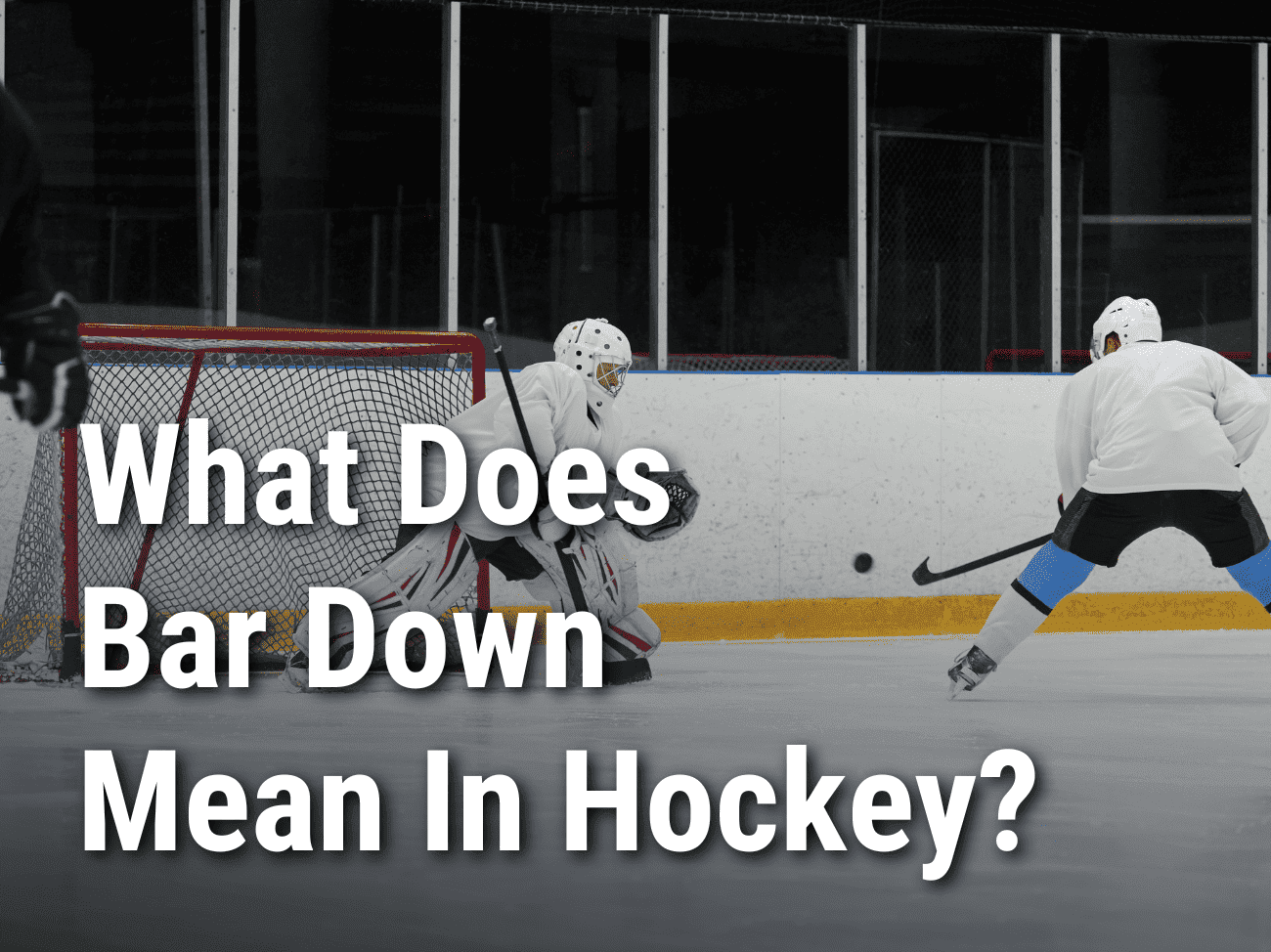In the exhilarating world of ice hockey, where goals are celebrated with unbridled euphoria, a phrase echoes through the arenas and locker rooms, capturing the essence of scoring brilliance: “Bar down.”
What does bar down mean in hockey?
“Bar down” in hockey refers to a perfectly executed shot that hits the crossbar of the goal and then goes into the net, showcasing the shooter’s exceptional accuracy and skill.
What Does Bar Down Mean In Hockey?
In hockey, “bar down” refers to a specific type of goal-scoring play where the puck hits the crossbar of the goal frame (the front, horizontal metal bar that connects the two goal posts) and then goes into the net.

When a player shoots the puck and manages to hit the crossbar with enough force that it rebounds into the net, it is often described as a “going bar down.”
Scoring a goal “bar down” in hockey is significant for a few reasons:
- Precision and Skill
- Hitting the crossbar with a shot and getting it to bounce into the net requires exceptional accuracy and skill. It demonstrates the player’s ability to pick a small target in a fast-paced, high-pressure situation.
- Aesthetically Pleasing
- Scoring “bar down” is visually appealing and exciting for players and fans alike. The puck hitting the crossbar and then dropping into the net creates a satisfying sound and sight, making it a highlight-reel worthy moment.
- Goalie Helplessness
- When a player scores “bar down,” it often leaves the goalie feeling helpless. The shot is placed in such a way that the goalie has little chance of making a save, as the puck is perfectly placed to avoid the goaltender’s reach.
- Momentum Shift
- Scoring a “bar down” goal can be a momentum-shifting moment in a game. It energizes the scoring team and deflates the opposition, leading to a potential shift in the game’s flow.
- Sign of Offensive Prowess
- Scoring “bar down” goals is usually associated with skilled offensive players who have a great shot and scoring touch. It showcases their ability to beat the goaltender with a well-placed shot, enhancing their reputation as a dangerous offensive threat.
Overall, “bar down” goals are celebrated and admired in hockey because they epitomize the combination of precision, skill, and flair that makes the sport so exciting to watch. They are memorable moments that often become highlights in sports media and contribute to the overall excitement and enjoyment of the game for players and fans alike.
What Sport Is The Bar Down Term Used In?
The term “bar down” is primarily associated with ice hockey.
It refers to a specific type of goal-scoring play where the puck hits the crossbar of the goal frame and then goes into the net. As I mentioned earlier, it’s a significant and celebrated achievement in hockey due to the skill and precision required to execute such a shot.

While the term “bar down” is most commonly used in hockey, similar phrases might be used in other sports that involve shooting a ball or puck into a goal.
For instance, in soccer (football), players might use the phrase “crossbar challenge” to describe hitting the ball so that it strikes the crossbar of the goal. However, it’s important to note that “bar down” is more specific to hockey and has become synonymous with scoring goals in that sport.
Why Do They Call It A Bar?
The term “bar” in the context of hockey, particularly when referring to “bar down,” comes from the physical structure of the goal frame.
The goal in hockey consists of two vertical posts connected by a horizontal crossbar, forming a rectangular shape. This structure is commonly referred to as the “goal frame” or simply the “net.”

When a player scores “bar down,” it means the puck hits the crossbar of the goal frame and then goes into the net. The phrase “bar down” is simply a colloquial way of describing this specific type of goal-scoring play.
The term likely originated from hockey culture and terminology, where players and fans often use shorthand expressions to describe different aspects of the game. Over time, “bar down” has become a popular and recognizable phrase used to celebrate a skillful and impressive goal in hockey, hitting the top of the goal frame before finding the back of the net.
What’s The Difference Between Bar Down And Top Shelf?
“Bar down” and “top shelf” are two different phrases used in hockey to describe specific types of goal-scoring plays, based on where the puck hits the goal frame.

While both phrases indicate skilled shots, they refer to different parts of the goal frame:
- Bar Down
- “Bar down” refers to a goal where the puck hits the crossbar (the horizontal metal bar) of the goal frame and then goes into the net. The shot is usually taken from a position below the crossbar and is aimed high enough that it strikes the crossbar before crossing the goal line. Scoring “bar down” is considered a display of precision and accuracy, as it requires the player to pick a small target and execute the shot with the right amount of force.
- Top Shelf
- “Top shelf” is a term used to describe a goal where the puck is shot high into the top part of the net, in between the front and back crossbars. When a player scores “top shelf,” the puck enters the net at the highest point, often over the goaltender’s shoulder. This shot is particularly challenging for the goalie to stop, as it is placed in one of the most difficult-to-reach areas.
In summary, the main difference between “bar down” and “top shelf” is the specific part of the goal frame where the puck hits.
“Bar down” refers to hitting the crossbar before the puck goes in, while “top shelf” means scoring high in the net, usually just behind the crossbar. Both types of goals are seen as skillful and celebrated moments in hockey, highlighting a player’s ability to execute accurate and powerful shots.


Leave a Reply